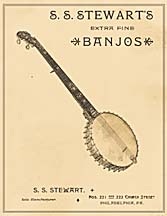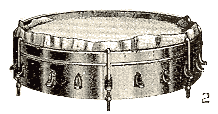A HEAD ON A BANJO.
We have in various publications and on different occasions explained in as clear and concise manner as circumstances would permit the manner of properly re-heading a banjo. But, at the same time, we have said that the matter of re-heading a banjo, like any other art, requires some experience and practice to properly acquire and become proficient in. Now, in order to give our readers a somewhat clearer view of the operation, and wishing all to have as clear and practical instruction as can well be given without personal contact with them, we have taken occasion here to go over the subject of PUTTING ON A HEAD, accompanying the explanatory remarks with a few wood engravings made from photographs of the work in the different stages of the operation. We might remark here that it is owing to the number of letters asking for these particulars that we have attempted to illustrate the subject, deeming the printed instructions formerly given insufficient to meet the wants of our customers.
The head, or skin, should be wet enough to make it pliable-but not soaked until it becomes too flabby. Therefore, to properly wet the head, roll it in a wet towel for two or three minutes, or immerse it in a tub of water for a short time. Some heads will become pliable in a few seconds of wetting, while others require as many minutes. The head that is most impervious to water and requires the more time to become pliable, will make the best bead after it becomes dry, as it will not be so ready to become slack in damp weather as the more pliable bead.
After the head has become sufficiently pliable, lay it on the rim of the banjo and place the wire ring, or " flesh hoop," over the head, thus bringing it down over the rim as shown in the fit at illustration. Be careful to draw the head evenly and have as few wrinkles in the skin as possible. If the wire ring (flesh hoop), is of iron, it is better to give it one or two coats of shellac varnish-well dried-or else to cover it with thin muslin over the varnish. This will guard against rusting. Every banjo player who wishes to put on his own heads (banjo beads, of course), should provide himself with SIX LONG HOOKS to be used especially for this purpose, as shown in cuts Nos. 2 and 3. Keep the wire hoop near the top of the rim and as even as possible; then, taking the hoop or band in one hand, tuck the edge of the head under the hoop and put on a long hook to hold the band in place. Now, tuck in more of the edge of the head, going around the rim, and put on another hook; do this again, going further around the rim, and your work has assumed the appearance of cut No. 2.
Proceeding with the work, put on a hook here and there as the head is tucked up, and after the entire circle has been gone around, take a pair of pincers and carefully pull the edge of the head tight and smooth (cut No. 3). But do not pull too hard, so as to tear the head. Try to have the head perfectly even and free from wrinkles and the hoop pretty well up above the edge of the rim. Now begin putting on the books and nuts which rightly belong to the instrument, and finally remove the six long hooks, replacing them with the others. Care must be taken that the head has not been drawn down or strained during this process, but the nuts on all the hooks left merely tight enough to hold them all in place.. Now, with a sharp knife, trim off all the circle of superfluous head-but be very careful not to cut the head and spoil all the work, just as you think you have it done. After the edge of the head has been trimmed off the work will assume the appearance of cut No. 4.
Of course, the edge of the head may be trimmed off before the long hooks are removed and the full line of hooks put on, if desired. But for a novice in the art of putting on heads we advise the former method. If the weather is clear and the air dry when this work is done, the head will become hard and dry in a couple of days, and the head can then be " pulled down," that is, you can take the wrench and tighten all the hooks evenly and thus gradually draw down the head. It is to be remembered that although with favorable weather a bead may appear to be perfectly dry and firm on its surface in a few hours after it is put on, yet that portion of the bead I which is under the hoop has not by any means become dry, and therefore should not be strained. It is quite possible after all this work has been gone through with to break the bead in pulling it tight. The head will require constant tightening now for a few days until the greater part of its stretching qualities have been removed, and it is quite possible that it may break. No one can be an infallible judge in regard to the lasting qualities of ahead; the best makers and players of a banjo being frequently deceived in them. It is quite impossible to get any two heads precisely alike. They may be selected of the same color and thickness, and same evenness of finish, and yet when they are put on be found to work differently. It does not matter whether a head is white or clear (transparent) so long as it is a good head. A good head may be broken by accident and need replacing. No matter bow good a head may have been, when once broken, it is done for-there is no use in patching it. A good banjo may sound dull on account of having a poor head, or one which has been loosely put on and cannot be properly stretched. The head is a ready absorbant of moisture' at best, and a poor flabby head which has been improperly manufactured is a curse to a fine banjo Any banjo will contract the " malaria with such a head. Do not strain a banjo head very tight until I has become dry and firm. The sun is the best head dryer, much prefer. able to a stove. When the weather is clear, the rim with newly placed head can be placed in the open air, exposed to the sun's light for a short time. But if the weather is very hot, with an intense sun heat, it is better to place the work so that the sun does not shine directly upon it-or, in -other words, place it out of the direct rays of the sun, and yet in such position as will allow the dampness to be absorbed. Should the sun shine or heat fall directly upon the bead and it thus be made to dry too quickly, it contracts and draws firmly upon the still wet or damp part of the bead which is around the wire hoop and under the hoop or band, and is, thus unnaturally strained and frequently caused to break. A head which has been strained very tight before becoming thoroughly DRY, will not fast as long as if it had been allowed time to become dry before being stretched. Putting a wet towel on a bead after it has been put on in order to keep it wet and cause it to stretch, is a very bad proceeding. Heads treated in this way will not last so long as they would if allowed to stretch gradually. Sometimes a head will last for years. Then again, two or three heads may be broken, one after another. Some players think it is like "Fisherman's Luck" to put on a head.
|
 HOW
TO PUT
HOW
TO PUT 


